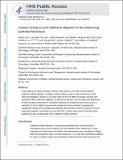| dc.contributor.author | Lee, Gyudo | |
| dc.contributor.author | Atia, Lior | |
| dc.contributor.author | Lan, Bo | |
| dc.contributor.author | Sharma, Yasha | |
| dc.contributor.author | Nissim, Lior | |
| dc.contributor.author | Wu, Ming-Ru | |
| dc.contributor.author | Pery, Erez | |
| dc.contributor.author | Lu, Timothy K | |
| dc.contributor.author | Park, Chan Young | |
| dc.contributor.author | Butler, James P | |
| dc.contributor.author | Fredberg, Jeffrey J | |
| dc.date.accessioned | 2021-10-27T20:09:26Z | |
| dc.date.available | 2021-10-27T20:09:26Z | |
| dc.date.issued | 2018 | |
| dc.identifier.uri | https://hdl.handle.net/1721.1/134842 | |
| dc.description.abstract | © 2017, © 2017 Taylor & Francis. At the edge of a confluent cell layer, cell-free empty space is a cue that can drive directed collective cellular migration. Similarly, contact guidance is also a robust mechanical cue that can drive cell migration. However, it is unclear which of the two effects is stronger, and how each mechanism affects collective migration. To address this question, here we explore the trajectories of cells migrating collectively on a substrate containing micropatterned grooves (10–20 μm in periodicity, 2 μm in height) compared with unpatterned control substrates. Compared with unpatterned controls, the micropatterned substrates attenuated path variance by close to 70% and augmented migration coordination by more than 30%. Together, these results show that contact guidance can play an appreciable role in collective cellular migration. Also, our result can provide insights into tissue repair and regeneration with the remodeling of the connective tissue matrix. | |
| dc.language.iso | en | |
| dc.publisher | Informa UK Limited | |
| dc.relation.isversionof | 10.1080/03008207.2017.1384471 | |
| dc.rights | Creative Commons Attribution-Noncommercial-Share Alike | |
| dc.rights.uri | http://creativecommons.org/licenses/by-nc-sa/4.0/ | |
| dc.source | PMC | |
| dc.title | Contact guidance and collective migration in the advancing epithelial monolayer | |
| dc.type | Article | |
| dc.contributor.department | Massachusetts Institute of Technology. Synthetic Biology Center | |
| dc.contributor.department | Massachusetts Institute of Technology. Department of Biological Engineering | |
| dc.contributor.department | Massachusetts Institute of Technology. Research Laboratory of Electronics | |
| dc.contributor.department | Massachusetts Institute of Technology. Department of Electrical Engineering and Computer Science | |
| dc.contributor.department | Massachusetts Institute of Technology. Center for Microbiome Informatics and Therapeutics | |
| dc.relation.journal | Connective Tissue Research | |
| dc.eprint.version | Author's final manuscript | |
| dc.type.uri | http://purl.org/eprint/type/JournalArticle | |
| eprint.status | http://purl.org/eprint/status/PeerReviewed | |
| dc.date.updated | 2019-07-18T13:35:16Z | |
| dspace.orderedauthors | Lee, G; Atia, L; Lan, B; Sharma, Y; Nissim, L; Wu, M-R; Pery, E; Lu, TK; Park, CY; Butler, JP; Fredberg, JJ | |
| dspace.date.submission | 2019-07-18T13:35:17Z | |
| mit.journal.volume | 59 | |
| mit.journal.issue | 4 | |
| mit.metadata.status | Authority Work and Publication Information Needed | |
